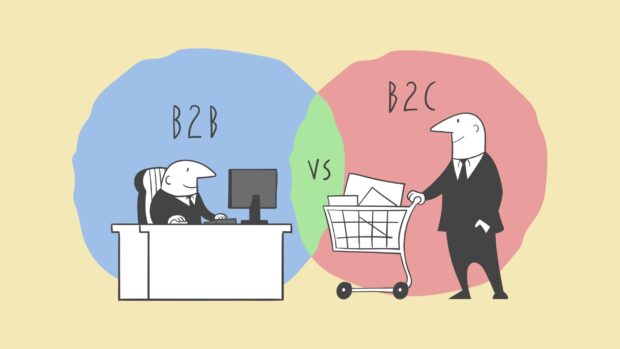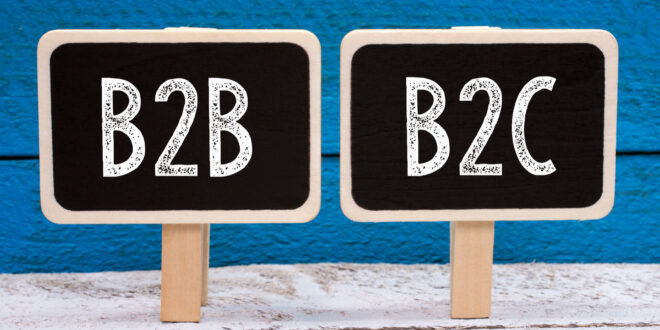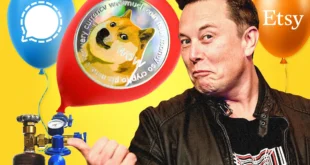A fundamental way to differentiate between businesses today is who they serve. The two primary classifications in that regard are businesses that sell to consumers and companies that sell to other businesses.
While seemingly similar, the differences between these two business types are essential to understand. The differences between B2B and B2C are significant in marketing.
As consumers of all kinds become increasingly sophisticated. As advertising channels become more focused and specific, marketing efforts have to adapt to these differences and take advantage of platforms, methods, and styles that are particular and effective to each one.
Since B2C and B2B customers are quite different in their background, goals, and spending patterns, creating a marketing plan for any business hinges on understanding what type of business segment the company is in and precisely who is buying its products. Content geared toward one element will be foreign to the other – in no way should B2B marketing and B2C marketing is considered interchangeable.
This article will present everything a beginner should know about B2B and B2C audiences and how marketing efforts between the two camps are similar and different.

What Is B2C?
B2C is short for business to consumer. B2C is a sales model that sells products and services directly from a business to end-user consumers. B2C companies sell directly to consumers.
B2C companies comprise most of the businesses that you see every day. This business can be a hardware store, a beauty salon, a car dealership, a massage therapist, and an online sporting goods store. As a sales model, business to the consumer can include:
- Eating out at restaurants.
- Seeing a movie in a theater or as a pay-per-view online.
- Shopping at a mall.
It can also include a wide range of online-only B2C websites like Amazon, Walmart, and Groupon.
A company that relies on the B2C sales model must have good relations with its customers. Therefore, their marketing campaigns typically use emotion to appeal to customers and encourage both first-time and return purchases.
What Is B2B?
B2B, or business to business, is a business model that sells products or services to another business. There are a variety of examples of when this model appears. For example, a business could buy materials needed for their production process from another business, or a business could hire another business to provide services for operational reasons.
In addition, this could cover situations where a business buys goods and services from another company, only to turn around and sell them to other companies.
Business to business companies is mainly invisible to many consumers. Still, they make up a substantial part of the economy of the United States. This fact is particularly actual for larger businesses.
B2B companies include Atlassian, DocuSign, Marketo, Unity Technologies, and Datadog.

Examples of Companies That Are Both B2C and B2B
Many companies bridge the B2C and B2B gap by serving both business models. These businesses are sometimes known as B2M, or business to many. B2M companies enjoy greater exposure but also more complicated marketing campaigns.
Examples of hybrid B2C and B2B companies include Amazon, Adobe, Verizon, and Farmers Insurance.
An additional segment to be aware of is B2B2C – short for business to business to consumer. In this market scenario, a company sells to another company that sells to a consumer. This model is growing in popularity for B2B companies to simplify their operations and build relationships with partners. As a result, both sides can maximize their business opportunities and achieve scalable growth.
For example, Company 1 can build its brand credibility and tap into its existing customer base. At the same time, Company 2 can take Company 1’s product and add a new or complementary service without investing internal resources to gain additional market share. Meanwhile, the consumer understands that although they give their money to Company 2, they buy Company 1’s products.
What Is B2C Marketing?
B2C marketing is a term used to describe how a business markets its products and services to individuals. B2C marketing is distinctly different from B2B marketing in both the style of marketing and channels used. These differences are significant because of the way products and services are purchased by consumers, how they make decisions and the overall cost of purchases.
At their core, consumer purchase decisions are usually impulsive and, at times, spontaneous. The contrasts significantly with B2B purchase decisions, including expensive research and seeing the purchase as an investment or business tool.
Consumers typically seek out products based on an immediate need, conducting less research and due diligence. While potentially more exciting, B2C marketers have a much shorter window to influence consumer behavior.
This shorter window is why B2C marketing campaigns often rely on emotion. Understanding this can guide how you conduct a B2C marketing campaign.
B2C marketers must closely track trends and research consumer purchase habits while monitoring their competitors’ tactics. Much of this comes down to content marketing.

Top Priorities for B2C Content Creators
Content marketing for B2C companies typically focuses on:
- Creating more engaging content: Content is a large part of making emotional connections with consumers and exciting content that works the best. This content can include everything from product descriptions to advertising taglines to social media posts.
- Better understanding what content works with consumers and what does not: B2C companies may only get one chance to connect with consumers. Their consent has to work right, and work right almost immediately. Since many B2C purchase decisions are spontaneous, hitting the mark the first time, and doing so often using a single image or a few words, is critically important. Equally important is not turning customers off by using contingent that is offensive, irrelevant, or plain old dumb.
- Creating visual content, including video: Images and video are critical in B2C marketing – the customer has to immediately visualize why they want the product and how it will improve their lives. Words help, but images and video often connect with core audiences.
- Repurposing old content to keep it current: Products, consumer purchasing patterns, and decisions change. Unfortunately, last year’s content may not be entirely relevant to consumer buying decisions this year. B2C companies need to constantly revisit old content to ensure it is on-trend. It also means new opportunities for creating valuable content that can connect with customers.
- Content optimization: When dealing with just a relative handful of words, each word counts. The same goes for social media posts, product images, taglines, and more. B2C marketers need to ensure every word they use counts, which means in-depth content optimization procedures.
What Is B2B Marketing?
B2B marketing is the process of marketing products or services between businesses and organizations. Therefore, B2B marketing is more informational and straightforward than B2C marketing and relies less on emotion and more on conscious reasoning. This method is because most business decisions are based on their impact on the bottom line, and return on investment is a crucial consideration.
In modern B2B environments, B2B marketers sell to a person and a buying committee, making for challenging and complex marketing tactics. According to DigitalAuthority.me, B2B marketing campaigns aim at those who make decisions at a high level or those who influence those decisions.

Critical Elements of a Successful B2B Marketing Plan
A B2B marketing plan will be markedly different from a B2C marketing plan, and with good reason. As shown earlier in this article, B2B marketing is focused less on emotion and more on return on investment. By buying a product from another business, the purchasing company will do more, sell more, engage more, save more money, or save more time.
Elements of a successful B2B marketing plan include:
- Setting SMART goals, objectives, and tasks: Start by analyzing your current situation, then look at where you want to go. Stay focused and set specific, measurable, achievable, relevant, and time-bound goals.
- Your website: This is where most of the action will take place. You want visitors to easily find the information they are looking for and quickly understand how buying it will improve their business.
The site must be aesthetically appealing and contain the relevant information that helps encourage a buying decision. B2B customers may act on some emotion. However, they also want to see a clear return on investment, focusing on specifics, statistics, and numbers. - Your content: Your content will get customers to your website and catch eyes when you advertise. Provide quality content that shows the benefits of your products and clear reasons why someone should buy them. Understand who will be looking at your products, who will make business decisions, where they spend their time online, and what motivates purchase decisions.
- Social media content and advertising: An intelligent B2B marketing plan will include organic and pay-per-click social content and advertising. Most business social activity is on LinkedIn and Twitter, although Facebook and Instagram can benefit certain businesses.
- Smart search engine optimization: Research long and short keywords that visitors use to get to your site and see if they mesh with your business goals. Then, research the keywords visitors use to get to your competitors’ websites. Embed these keywords into usable content, ranging from landing pages to search engine ads, headings and subheadings, blogs, social media ads, and more.
- Analyzing your data: Analytics are critical for B2B marketing campaigns. You should collect data on campaign effectiveness, analyze it, and make changes based on it. Study data from the current campaign and compare it to data from previous campaigns. What worked? What flopped? Where are there opportunities for new engagement and success?
What Are the Key Differences Between B2B Marketing and B2C Marketing?
Now that you know more about B2B and B2C marketing, it is essential to understand how they differ.
- Customer relationships: B2B focuses on building personal relationships that are mutually beneficial and show a key return on investment for the purchaser. B2B is focused on lead generation and lesson brand awareness, meaning that B2B marketers must focus on developing repeat and referral business. B2C, meanwhile, is focused on transactional relationships that turn regular customers into brand ambassadors who will do part of your advertising for you.
- Branding: Again, B2B is focused on relationships, while B2C focuses on messaging. Branding is crucial for B2C since it allows the business to precisely deliver a message, create loyalty, and connect emotionally to influence the buying decision. B2B focuses on the consistency of the presentation and the delivery of products or services.
- Decision-making processes: Since B2B is transactional, the decision-making process must focus on open communication so both parties can clearly understand if the transaction is in their best interests.
B2B customers will evaluate a product and match it to the needs of their employees or customers to answer the question: Is this a good investment. B2C customers, meanwhile, will want a simple process. They are likely more flexible when deciding what to buy. The seller must constantly see what the competition is doing to ensure they remain top of mind. - Advertising copy: Words appeal to a broader audience because B2B and B2C customers are radically different. In B2B, sellers must know their customers’ lingo and speak their language. For example, selling a tractor to a construction company cannot rely on a fluffy feel-good copy. It must display a knowledge of the work and a clear representation of the benefits of your particular tractor. In B2C, meanwhile, since the purchase decision is more abrupt and emotional, marketing copy should use a relatable voice that entices the customer to click and then stirs an emotion that encourages the sale.

What Are the Key Similarities Between B2B Marketing and B2C Marketing?
Yes, B2B and B2C are hugely different in marketing strategy. And yet, there are also plenty of similarities, including:
- In both cases, you are selling to real people who have real needs and problems that need solving.
- Both require exceptional customer service and great customer experiences.
- In B2C and B2B, the seller needs to solve the buyer’s problems.
- For both categories, sellers need to focus on credibility and authenticity.
- Also, sellers need to build trust for both categories to complete a sale.
- In both cases, the buyer’s journey does not end when clicking the purchase button – it almost always continues long after the purchase. It can impact both future purchase decisions and word-of-mouth recommendations.
- Customers in both market segments are more knowledgeable than ever and better informed, particularly regarding value.
- Both company types are focused on filling their sales funnel with quality leads.
- Both segments of customers expect the companies they buy from to match to some extent their personal views, whether those are social, political, or environmental. Today, customers see their purchase as a simple transaction and a unique political statement more than ever.
Conclusion: Both Landscapes Change Frequently
As technology and buying patterns continue to evolve, both B2B and B2C marketing strategies must hustle to keep up. New trends will emerge, and new expectations will evolve. However, the good news is that marketers for both B2C and B2B businesses have a wealth of tools and technologies at their disposal to reach new customers and strengthen existing relationships in ways that seemed far-fetched just a decade ago.
Now, more than ever, B2C and B2B marketers can envision, launch, and monitor high-quality campaigns that deliver accurate bottom-line short-term and long-term results that help them compete in highly competitive environments.
 Comeau Computing Tech Magazine 2024
Comeau Computing Tech Magazine 2024




